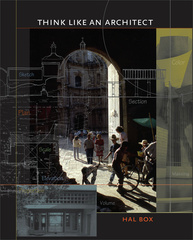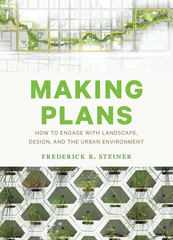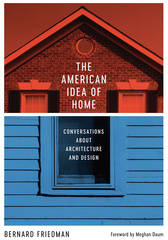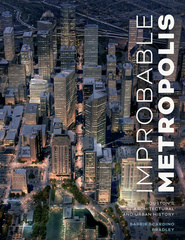
The Open-Ended City
David Dillon on Texas Architecture
Texas Historical Commission Award of Excellence in Media Achievement, Texas Historical Commission
In 1980, David Dillon launched his career as an architectural critic with a provocative article that asked “Why Is Dallas Architecture So Bad?” Over the next quarter century, he offered readers of the Dallas Morning News a vision of how good architecture and planning could improve quality of life, combatting the negative effects of urban sprawl, civic fragmentation, and rapacious real estate development typical in Texas cities. The Open-Ended City gathers more than sixty key articles that helped establish Dillon’s national reputation as a witty and acerbic critic, showing readers why architecture matters and how it can enrich their lives.Kathryn E. Holliday discusses how Dillon connected culture, commerce, history, and public life in ways that few columnists and reporters ever get the opportunity to do. The articles she includes touch on major themes that animated Dillon’s writing: downtown redevelopment, suburban sprawl, arts and culture, historic preservation, and the necessity of aesthetic quality in architecture as a baseline for thriving communities. While the specifics of these articles will resonate with those who care about Dallas, Fort Worth, and other Texas cities, they are also deeply relevant to all architects, urbanists, and citizens who engage in the public life and planning of cities. As a collection, The Open-Ended City persuasively demonstrates how a discerning critic helped to shape a landmark city by shaping the conversation about its architecture.
A welcome reminder of [Dillon's] intelligence and flair for the mot juste…Together, the essays describe a critic who engaged architecture in the broadest sense, looking not just at individual buildings, but at the impact of urban planning decisions, transportation systems, housing policy, history, and the relationship between city and suburb.
Many of the pieces will resonate across the country, especially in postwar Sun Belt cities, but North Texas is lucky to have Dillon's observations contained in this resonant volume…It is built to last.
With articles in chronological order across each chapter and titles that are highly descriptive..., it's easy to jump around [The Open-Ended City] based on one's interests. Of course, given Dillon's focus on local criticism, residents of Dallas will be drawn to the book more than outsiders. But in 2019, when architectural criticism in the US is hard to come by..., Dillon's articles still provide plenty of lessons while tracing a changing metropolis he influenced in his own way.
From the first essay to the last, [David Dillon] condemned simplistic 'big-picture thinking'...and argued for design that would bring actual human connection back to city streets. Holliday writes that Dillon 'maintained a persistent belief in the ability of an engaged citizenry to demand higher quality and greater accountability for urban context,' and that he championed 'a richer social life for the city as a whole.' That makes him a model worth emulating, and his essays worth reading.
Dillon is...among the few Texas newspaper writers whose columns have been collected in book form. As such, his pieces on social equity, land use, suburban sprawl, downtown redevelopment and historic preservation can be read in any order and enjoyed for their potent opinions and carefully laid out arguments.
[The Open-Ended City] is constructed in a way that highlights Dillon’s varied interests, and his voice, as well as his unique ability to '[tell] stories about architecture and cities [through] focusing on stories about people'...Dillon’s writing, and [Kathryn] Holliday’s editing of it, remind us that there must be careful watchers of the collisions that happen on the seam where public projects and private money meet. This book is an example of the fourth estate at its best. Not moralizing, not virtue-signaling, but compelling description, subtle perception, and the ability to capture the imagination via character, narrative, and gorgeous prose.
David Dillon was one of America’s most incisive, literate critics, but because he was based in Dallas at a time when there was no social media or internet to boost his reputation and distribute his work, and because he died too young, he never received the national attention he was due. This collection will introduce him to a new generation of readers around the country, while reminding his longtime fans of the scope and brilliance of his writing.
David Dillon began writing about Texas architecture at one of American architecture's lowest moments, the 1980s. 'Why is Dallas architecture so bad?' he asked. Over the next three decades, as this vibrant collection shows, he answered his question not by picking on individual buildings but by picking apart how cities, regions, and even McMansions are made. With steady optimism and a broad, national perspective, he helped frame debates about public and private space that continue to this day. Dillon's clarity, humor, and doggedness are a model for the contemporary critic.
- Foreword (Robert Decherd)
- Acknowledgments
- Introduction (Kathryn E. Holliday)
- 1. THE CRITIC’S VOICE
- Why is Dallas architecture so bad? Because we’re trying to look like too many other cities: big and boring, D Magazine, 1980
- Architecture criticism and the public, Texas Architect, 2009
- 2. RETHINKING DOWNTOWN
- Erik Jonsson: Contemporary Dallas is a testament to his grand vision as mayor, August 17, 1986
- How best-laid plans of ’60s helped create urban division, December 8, 1991
- Putting her faith in people, not systems: Author Jane Jacobs talks of how city planning fails, and offers some solutions, May 14, 1993
- DART-chitecture: Light-rail system’s clean design enhances Dallas, June 18, 1996
- Urban salvage: The loft life is transforming downtown, March 8, 1998
- Arts magnet: Fort Worth is trading its “Cowtown“ image for one geared more toward culture, May 3, 1998
- Shock of the NEW: The downtown-housing boom has forged winners and losers, January 14, 2001
- Quick-fix syndrome: To revitalize downtown, the whole must outweigh the parts, March 31, 2002
- Dallas at the tipping point: Community, April 18, 2004
- Forward Dallas: Would it work? Yes, if the city finds the money and leaders to see it through, says architecture critic David Dillon, May 7, 2006
- Uptown’s victory in the making: After early struggles, Perot Jr. presides over urban boomtown, June 21, 2006
- 3. THE METROPOLITAN LANDSCAPE
- A trip down memory four-lane: Highway 80 once carried travelers from coast to coast. Super highways put an end to that, but not to its vintage charms, April 7, 1985
- Why we should love freeways: Dallas was built not only by freeways but for them—made to be seen at 60 mph with the top down, June 3, 1990
- Tower power: Water tanks rise to provide scenery, a sense of place, ad space, islands of roadside whimsy, January 20, 1991
- Building a city’s future: Habitat for Humanity has an answer for urban blight, October 4, 1992
- This idea won’t hold water: Trinity River Parks Plan will only create a river of concrete, May 30, 1993
- Big mess on the prairie: The ubiquitous “North Dallas Special“ becomes a Texas tradition, October 2, 1994
- Safe havens: Gated communities are appealing to today’s yearning for security, June 19, 1994
- Stream dreams: The Trinity River plan is huge; so are its potential problems, August 15, 1999
- Set sail with the latest Trinity River Plan: With something for everyone, time to begin long-delayed project, March 30, 2003
- Shelter and shade: A city project brings architecture to the people, May 1, 2008
- 4. ARTS DISTRICTS
- Is there a place for the arts in the Arts District? Conceived as a downtown cultural oasis, it’s developed into a real estate playground, October 13, 1985
- Can sculpture keep its place in the sun? Giant skyscrapers threaten to overshadow DMA garden, July 2, 1985
- Donald Judd’s austere kingdom: A sculptor driven by a powerful vision has made the southwest Texas landscape his own museum, February 12, 1989
- Remaking a masterpiece: The Kimbell should rethink its expansion plan, October 29, 1989
- San Antonio museum: A recycling success story, April 21, 1991
- Economy, additions revive Arts District: Backers hope area at last fulfills its potential, July 26, 1998
- Constructing culture: New museums are springing up in all corners of Texas, April 18, 1999
- Hidden riches: A calm exterior doesn’t give away new Houston museum’s interior surprises, March 25, 2000
- State of the arts in Fort Worth: Museum is latest gem in Cultural District, but area still lacks identity, November 17, 2002
- Thoroughly modern museum: The Kimbell’s new neighbor is strong, simple building design at its best. Serene spaces, commitment to craftsmanship help reaffirm FW’s standing as an oasis for art, December 8, 2002
- Knitting together the Arts District: Master plan for performance center envisions an area linked by plazas, greenery, and people, September 10, 2003
- A design so artful, you may not notice: At Nasher Sculpture Center, what you don’t see is as impressive as what you do. Architect Piano creates a precise blend of light, texture, and mood, October 19, 2003
- 5. HISTORIC PRESERVATION
- Preserving a painful past: Controversial tower would bring people to Oswald’s perch, August 16, 1987
- The storm over Mrs. Craft’s house: The late civil rights leader’s home offers a lesson in the politics of preservation, March 13, 1988
- The state of State-Thomas: A once-vital downtown area is poised to come back to life. So why doesn’t it? December 25, 1988
- Urban History: Fort Worth’s Southside has stayed in character, March 23, 1989
- Library or parking lot? Time is running out for a downtown Fort Worth landmark, September 1, 1990
- In Grapevine, everything old is news: City hopes efforts to preserve its past will be drawing card for business in future, November 3, 1991
- Preservation times two: New museum will hold history of women and Fair Park building, October 18, 1998
- A tale of two houses: Notable buildings face different fates as preservationists and developers clash, January 4, 2004
- Saving beauty: The quirky glories of the Mercantile Building escape the wrecking ball, February 19, 2006
- 6. TEXAS ARCHITECTS AND DEVELOPERS
- The education of Harlan Crow: The son of the world’s largest developer wants to build a few good buildings and a liveable downtown. But first, he had to teach himself how, November 11, 1984
- Dilbeck, Meyer, and Ford: Dallas architects of the forties and fifties and their enduring contributions, October 6, 1985
- Dream houses: Rediscovering Hal Thomson’s legacy of architectural eclecticism, January 25, 1988
- Young guns: A new generation of architects is redrawing the Texas landscape, June 23, 1991
- Art and commerce: Dallas architects Lang & Witchell left a legacy of eclectic designs, July 5, 1992
- Artists in residence: A handful of architects champion modern flair amid retro-house Dallas, June 23, 2002
- Dallas developer builds reputation for creativity: Cheatham’s eclectic mix of modernity has trusted foundation, June 23, 2002
- Stately grace: Meadows exhibit celebrates Mark Lemmon’s landmarks, April 11, 2005
- 7. AESTHETICS AND ARCHITECTURE
- Built fast: But they last. Avion Village was built as temporary wartime housing in 1941, but its sturdy, prefab walls are standing strong forty-four years later, July 28, 1985
- Borrowing from the past: Industrial-age Crystal Palace influences computer-age Infomart, January 13, 1985
- Instant history on the prairie: In drawing on the past, architects have achieved the hopelessly eclectic in the new land north of LBJ, January 19, 1986
- The Crescent: Dallas’s newest, glitziest high-rise promises us a great building, but does it deliver the goods? March 30, 1986
- A prism on the skyline: Allied Bank Tower adds a unique and changing shape, September 28, 1986
- The new skyline: Once it looked like Everytown, USA. Now Dallas has grown up, December 13, 1987
- A decade of dazzle: At its ten-year mark, the Hyatt says “Dallas“ like no other building, May 10, 1988
- Painting the prairie: IBM’s splashy new headquarters brightens a gray flannel image, October 9, 1988
- A sound beginning: The Meyerson—elitist enclave or municipal monument? September 17, 1989
- An old friend triumphs anew: The Hall of State redo affirms the power of great architecture, November 14, 1989
- A way of life set in stone: Cistercian Abbey’s church evokes history, May 29, 1992
- Score it a hit: The Ballpark in Arlington may not be a home run, but it’s pleasing enough to drive in plenty of fans, April 10, 1994
- The Rachofsky residence is an artistic triumph: Meier’s world-class design achieves his utopian ideal, November 10, 1996
- Routine flight: By playing it safe on design, the new arena misses the chance to soar, July 30, 2001
- A monument to heroes: Dallas Police Memorial is an edgy, contemporary tribute that’s a triumph, April 8, 2001
- Let it be: Don’t move it or redesign it. The JFK Memorial is what it is, April 10, 2006
- Afterword. The Tradition of Architecture Criticism in Texas (Stephen Fox)
- Index











